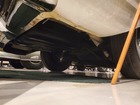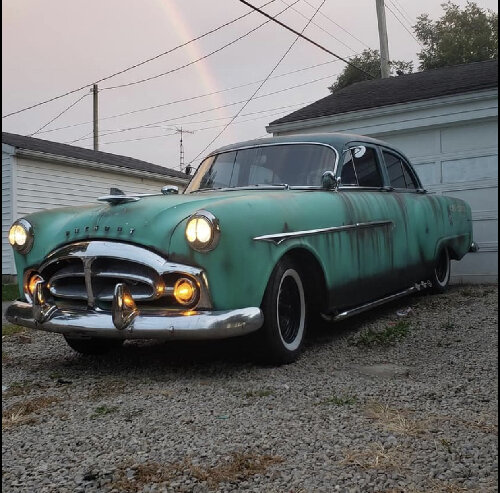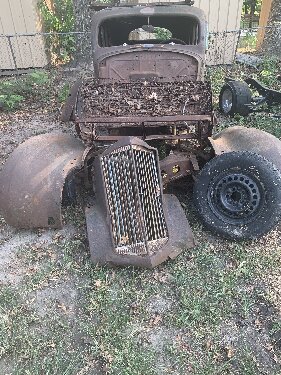|
Re: Question about a 48 Station Sedan at Barrett-Jackson
|
||||
|---|---|---|---|---|
|
Home away from home
|
My comment about the economic appreciation was somewhat ‘tongue in cheek’. I agree with all of the observations of the items that would need attention to move the car closer to the way it originally left Detroit. I’m not really surprised that the current owner would like to maximize the sale price . . . although the car hasn’t sold yet!
Several pictures on the Barrett-Jackson web-site appear to be identical to the images in the craigslist advertisement. Either the current owner had access to the photos taken by the previous owner, or the vehicle never changed hands three years ago.
Posted on: 2023/2/3 11:12
|
|||
|
||||
|
Re: Various CL Pickings
|
||||
|---|---|---|---|---|
|
Home away from home
|
The '48 Station Sedan has appreciated since I last saw it at a Barrett-Jackson auction. See:
https://packardinfo.com/xoops/html/modules/newbb/viewtopic.php?post_id=218530&keywords=barrett-jackson Jan20 $24.5K Jan23 $45.0K
Posted on: 2023/2/2 19:53
|
|||
|
||||
|
Re: Fasteners
|
||||
|---|---|---|---|---|
|
Home away from home
|
Kev if you’re looking for bolts with an integral ‘washer’ they are known as flange bolts. McMaster-Carr has such in various strengths, material, and thread configurations. Depending on which you select the package quantity is 5-100. I’ve also purchased them at the local ACE Hardware sold individually. They had a black oxide finish.
I’ve also put a black oxide finish on hardware store bright plated bolts. That process starts with a soaking in Lysol toilet bowl cleaner ( 9.5% hydrochloric acid ), and once the bubbling stops a quick rinse in hot water followed by a few minutes in Caswell black oxide solution. The final step is several coats of preservation oil. I think the oldest set of hardware that I’ve treated is about 10 years, and there is no hint of corrosion (rust). I’ve also treated a few sheet metal wing nuts for the battery hold-down on my ’48, and they are equaling doing well. dp
Posted on: 2023/1/27 11:11
|
|||
|
||||
|
Re: Mike's 53 Caribbean
|
||||
|---|---|---|---|---|
|
Home away from home
|
It’s hard to tell from the photos, but ‘in-board side’ brush holder looks like it over hangs the end of the commutator. I would investigate that once you’ve disassembled the generator.
dp
Posted on: 2023/1/23 12:49
|
|||
|
||||
|
Re: KPack's 1954 Panama
|
||||
|---|---|---|---|---|
|
Home away from home
|
Kevin
I was quickly educated by my wife on fabric measurement. In her world the material was 54 inches wide, and the product would be sold by length . . . and they used the units of yards when referring to length. When my lizard brain heard the word ‘yard’ I quickly switched incorrectly into the area mode. In her world the bolt of fabric, that would also include vinyl, would be brought to the cutting table and cut to length, not width. Pricing was stated ‘per yard’, but the actual length was whatever the customer wanted. They used POS calculators to do the arithmetic. The questions you need to ask are, what is the width of the product, and is the product priced by the length? The bolt width is not necessarily a single value from one industry/supplier to another . . . 45, 54, and 60 inches are typical, but you better ask. Ultimately, she brought home a partial bolt of green vinyl that matched the interior of our ’54 quite well . . . it was ‘on-sale’ and she had a coupon, plus an employee discount. We were both happy. dp
Posted on: 2023/1/15 14:02
|
|||
|
||||
|
Re: BigKev's 1937 115-C Convertible Coupe
|
||||
|---|---|---|---|---|
|
Home away from home
|
Kev:
7/8 inch diameter would suggest 270 ftlbs, but before I jumped into the deep end I would torque to 200 ftlbs plus whatever it took to get to the next castellation. And then recheck at 200 ftlbs in 100 miles. My concern is my ignorance on the pre-war materials and heat treating versus the post-war hardware. I would also clean up the nut face and washer especially if they are heavily scored. I don’t know of any technical reason stopping you from just backing up if you over torque and miss cotter pin alignment the first time. I’ve doubled checked and confirmed 100 ftlbs is appropriate for a 5/8 X 18 axle. That’s the Brand X configuration and it’s ben OK for some 95 years at that torque, so perhaps my concern about pre-war materials is unfounded. I watched your video . . . I must get a Big Orange Hammer! dp
Posted on: 2023/1/13 22:15
|
|||
|
||||
|
Re: BigKev's 1937 115-C Convertible Coupe
|
||||
|---|---|---|---|---|
|
Home away from home
|
Axle nut torque:
The desired torque should be a function of the tread diameter and pitch. For the later cars both the 3/4 X 16 and 7/8 X 14 had a call-out of 200 – 270 ftlbs. If the ’37 has something smaller than 3/4 inch diameter then the later torque specification IMO would not apply. My ’35 – ’42 Motor’s Manual is silent on the subject as is the ’40 – ’54 version of the manual. My tool handbook (circa ’49) lists the failure torque of a 3/4 -16 as 390 ftlbs, and 7/8 – 14 as 625 ftlbs. If the ’37 Packard has a smaller axle thread diameter/pitch of say 5/8 – 18 that failure torque is listed as 220 ftlbs. It would appear that Packard was comfortable pushing the fastener to about 70% of the failure torque for the junior cars, but the senior cars pushed only to 43% of yield. If you find the axle thread is 5/8 – 18 then consider 110 ftlbs (50% of 220), otherwise for the 3/4 -16 shoot for the low side of the later car specification 200 ftlbs (≈50% of 390). There was no mention of lubrication, so I’m assuming dry thread and washer surfaces in the above data. I would ‘stone’ the nuts to get the cotter pin to fit versus ramping-up the torque. dp
Posted on: 2023/1/13 15:00
|
|||
|
||||
|
Re: BigKev's 1937 115-C Convertible Coupe
|
||||
|---|---|---|---|---|
|
Home away from home
|
Kev, thanks for the correction . . . I must have misidentified your chassis number, and then worked upward in the parts listing, thus completely missing the last line. Even with all of the springs identical I could still get the primary moving first by having the hole in the shoe closer to the anchor. That would really confuse things by now having, in addition to shoe length, primary and secondary shoes with different spring hole locations, but the whole industry is driven by ‘lowest cost design wins’. Or perhaps the whole mess of primary and secondary shoes was overcome with better friction materials.
As far as I know the tapered rear bearing design with the thrust block was introduced with the ’38 JRs. In the land of Brand X low torque on the axle nut is believed to be a contributor to axle failures. In my ’48 Eight fatigue cracking started at many origins in the radius between the taper and threads, which lead to the wheel coming off, but thankfully the drum and shoes kept the wheel walking only about an inch down the taper. Perhaps with the axles ‘in hand’ you can give them a thorough inspection. dp
Posted on: 2023/1/12 22:48
|
|||
|
||||
|
Re: BigKev's 1937 115-C Convertible Coupe
|
||||
|---|---|---|---|---|
|
Home away from home
|
The comment about the same springs is odd to me in that the parts books has two different springs for all 22nd to 54th series cars. Not the same spring for every series car, but for any one brake configuration there were two different springs. Having said that once the material is selected there are only a few characteristics that make one coil spring ‘stiffer’ than another. The wire diameter, number of coils, and mean diameter of the coils are variables that change the fundamental stiffness (pounds force per inch deflection). Since there is no reason to have different spring rates in a brake drum application I would bet the stiffness is the same for both the primary and secondary application. The only variable left is the initial preload which is determined by the difference between the installed and uninstalled length of the spring. The only difference between the two springs may be the uninstalled length . . . and not by a lot . . . maybe something like 1/8 inch.
If I was in the business of making brake springs I would advocate using the same stiffness (wire, coil count, outer diameter), and make the difference in the uninstalled length. In that way I could have my winding machines running full speed ahead, and manage filling purchase orders at the hook bending production step. Let’s not forget the different color paint. The ’54 shop manual associates an orange spring for the primary shoe, and a yellow spring for the secondary shoe. Some seventy years later I wouldn’t expect the supply chain to use the same Packard color codes, but if there is a difference in the springs I would expect two different colors . . . and that difference may only be the length . . . shorter is the secondary. The artwork that Howard posted (bottom of page 209) shows the ‘extra’ spring on the secondary side, so if the ‘extra’ brackets are on the trailing half of the backing plate then I think those ‘extra’ springs are there to ensure the primary shoe moves first. dp
Posted on: 2023/1/12 18:35
|
|||
|
||||








